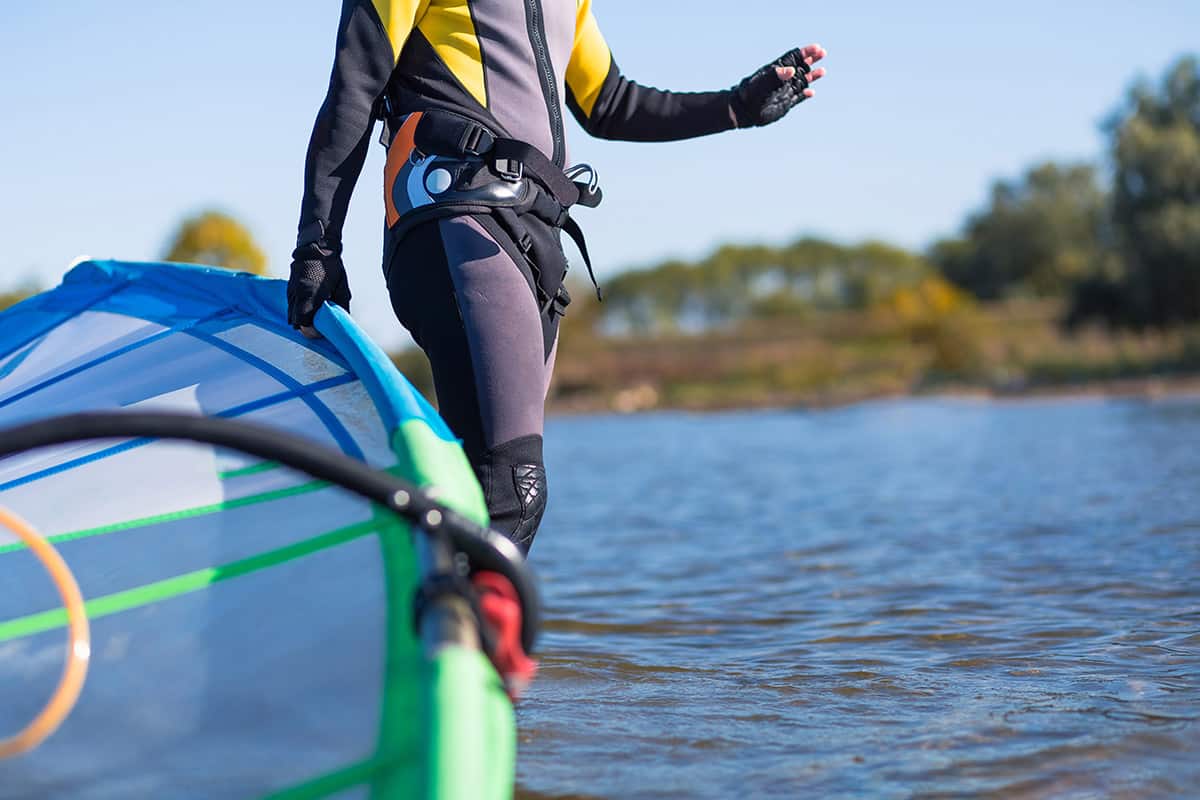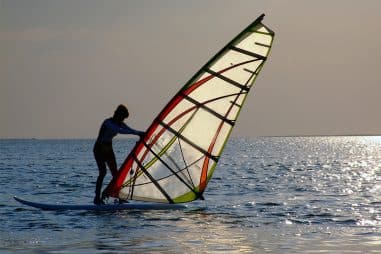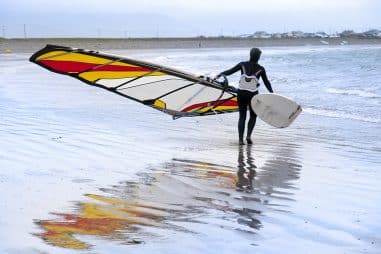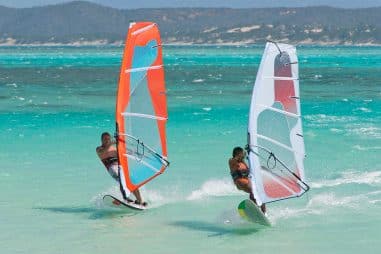A typical windsurfer is composed of the following components. Some parts are optional depending on the sailor’s preference and the type of sailing to be carried out.
- The board’s size is determined by the sailor’s skill level and weight. Generally, beginners’ boards are bigger and heavier than the more advanced sailors’ boards. This gives the learner more stability and control while the smaller and lighter boards give the experienced sailors maneuverability to perform more tricks.
Newbies’ boards vary from 285 to 333 centimeters in length with widths from 72 to 111 centimeters. Displacement volume is in the range of 145 to 250 liters. Intermediate surfers’ boards vary from 261 to 290 centimeters in length with widths from 70 to 85 centimeters. Displacement volume is in the range of 95 to 186 liters. - The sail is the next most important part of your kit. The size of the sail is also dependent on your skill level as well as the type of sailing and maneuvers you want to execute. The sail’s material also varies according to your preference and budget.
As a rule of thumb, you will need a smaller sail when the wind is brisker. This also depends on your weight and your maneuvers. Since it’s impractical to lug around too many different sail sizes when you go windsurfing, be sure to check the weather forecast before heading out unless you have the means to carry it all around. - The mast connects the sail to your board. The easiest option is to purchase the mast from the sail’s manufacturer so you can be sure it matches your sail’s specifications. However, if you are looking for specific performance from your mast, you may buy it separately from your sail.
Aside from the mast’s material, another factor that will impact its performance is its stiffness. A stiffer or a less stiff mast will alter the performance of the sail for which it is designed. How the masts bend or curve during a sail also affects performance. A smaller or bigger diameter mast will also affect how you execute your moves as this will change how you hold on to it. - The boom is attached to the mast and encircles the sail to provide support to it. The sailor grips the boom to adjust the sail’s angle during sailing and maneuvers. It comes in different materials, lengths, and diameters to fit different sail sizes.
- Other parts and accessories are the harness and harness lines, the fin, and the assorted rope system for the sail.
- Other accessories like the foot strap and daggerboard, although optional, will contribute to a more enjoyable sail.
How Do You Rig a Windsurf Board?
Follow the steps below to put together your board and sail:
- The first thing to assemble will be your mast as it usually comes in two sections. Make sure that the joint is smooth and dirt-free before pushing it together. Slowly ease the assembled mast through the sail’s mast holes. It should fit snugly so there is no need to rush pushing it in. Some sailors prefer to insert one part of the mast into the luff (more on this later) and connect the other part when the first half is fully inserted. Now attach the mast extension to the bottom.
- Tighten the luff on your sail by following the manufacturer’s instructions. The instructions are in the owner’s manual but sometimes it is printed on the sail itself. Thread the rope through the sail’s sheaves and down to the mast extension. Pull it as hard as you can to tighten it. If you need a tool to pull it tight, use one by all means.
- When the top of the sail gets floppy, secure the end of the rope to the mast.
- Now, attach the boom to the sail by clamping it in place. The boom should at least be chest high. The wider part of the boom goes on the mast.
- Follow the manufacturer’s instructions on how to fix the boom to the sail. The rope is normally threaded through the bottom of the boom and tightened.
- Turn your sailboard over to attach the fin with a screwdriver. The daggerboard is usually attached to the board already. You may flip it up and down as you want.
- Line up the mast to the mast base and pop it in firmly. The base should already have been screwed to the board. You are now ready to enjoy the day with your windsurfer!
How Do You Attach a Boom to the Windsurf?
- First, decide to buy a clamp-on boom. This will save you a lot of headache and time when attaching it to your sail.
- The wide part of the boom goes to the mast side of the sail. Simply attach the boom by its clamp to the mast. The boom should be at about the height of your chest when the mast is mounted on the board. A rope is used to additionally tighten the clamp’s hold on the mast. Instructions on how to use the rope to tighten the clamp are included when you purchase your boom.
- The narrow side of the boom has an adjustment so you can extend the “legs” on that side. Extending the “legs” will give you more space and make it easier for you to slide the boom over the sail. Adjust the “legs” to their ideal length according to the size of your sails. Thread the outhaul rope through the boom and sail and tighten according to the preferred tension.
How Do You Attach a Windsurf Uphaul?
The uphaul is the piece of rope by which you pull the sail upright when starting to windsurf or during a waterstart. The uphaul is fixed to the head of the boom which in turn is connected to the mast. The other end of the uphaul is connected to the mast base. This keeps the uphaul in place and easy to find.
The uphaul may be attached to the boom head through a rope and elastic already affixed on it. Sometimes the boom head has a hole through which the uphaul may be looped. Whatever the case, a means of attaching the uphaul to the boom head is already provided. There is no need to look for alternative ways to attach it to your rig.
How Do You Rig an Old Windsurfer?
Some people may want to start windsurfing with an old-style board and rig. This is partly to not wanting to spend so much on it before deciding they like windsurfing enough to buy some brand-new and modern equipment. They may want to begin with affordable second-hand stuff just to see if they like the sport. Using old equipment comes with its own challenges, not the least of which is rigging the sail. Below are the steps to rig an old windsurfer.
- To rig an old-style windsurfer, you are going to need extra ropes. You will need the rope to tie the boom head to the mast with a rope the same size as the downhaul rope. You will need a rope with a diameter of around 6-8 mm and a length of about 50-60 cm.
- Thread one end of the rope through a hole in the head of the boom. After inserting the mast into the sleeve, attach and tighten the downhaul.
- Now, slide the boom over the sail and position the boom head on the mast. The boom head should be opposite the downhaul and the tail of the boom positioned near the top of the sail. The boom should more or less have an angle of about 45 degrees to the mast.
- Wrap the rope around the mast three times, going underneath the boom head first before coming up on top of the boom head in a full wrap three times. Thread the remaining end of the rope through the cleat of the boom head. Rotate the mast and clamp off the ends of the rope.
- Bring the other end of the boom down so it is perpendicular to the mast. This will tighten the rope at the masthead even more. Once the boom is secure, attach the outhaul and check if the sail is rigged properly.
What is Luff in Windsurfing?
Sometimes also called a luff tube, the luff is the part of the sail which contains the mast. This nautical term is used not only for windsurfing sails but for sails in general. The luff has the most static load in a sail. The luff’s material must resist stretching so it does not come loose in the mast. The mast should remain snug in the luff.
How Long Should Windsurfing Harness Be?
Longer is better for the harness lines so goes the common wisdom. A better answer would be what works best for you. Remember, you should be aiming at getting your rig as vertical as possible. The length of your harness lines should help you do this.
Longer lines will provide you with more room between the boom and your body while sailing. It also gives you more leg space under the boom so you can better sail through waves and rough water. It also makes it easier to keep sailing in a lull with longer lines due to the better sail position.
How Do You Measure Windsurf Harness Lines?
The longer harness lines preferred by the pros may not be so easy to use for us mere mortals. A common way to measure what is a compromise length of the lines is to fix the line on the boom, insert your arm up to the elbow where the line bends, and have about two-thirds of your palm just under the boom. This is not a hard and fast rule, just a starting point from where you can adjust the length to your liking.
Harness lines are usually measured in increments of 5 centimeters starting from 50 centimeters to more than 75 centimeters. There are some adjustable harness lines in the market that make it easier on the wallet for those who are on a budget. You can even adjust them while you are hooked in. They have line length markers so you can recall which line length works best for you.
How Do You Adjust Windsurf Harness Lines?
A type of on-the-hook adjustable harness can be used while sailing by fixing both ends of the harness line on the boom. If you need to adjust it on the fly, pull the loop to shorten the line. A non-slip buckle needs to be released first and then locked once you have adjusted it to your desired length to lengthen the line. A-line length marking is printed on the line so you can identify your preferred line length.
The harness line is supposed to help you maintain the sail in the upright position and improve your stance and balance. Adjusting the harness lines is about fine-tuning the space between hands, the length from boom to harness hook, and the position of the harness in the boom. Where to position the harness in the boom is a matter of personal preference and what type of sailing you will undertake.
How Do You Clean a Windsurf Board?
It is quite common to get scuff marks and other dirt on the surfboard. The mast or the boom would scrape the board, sand gets caught between the feet and the board, etc.
A simple way to clean the board is to use an ordinary cleaner that you usually use to clean kitchen counters, tabletops, and furniture. The cleaner won’t have chemicals that may harm the board. Use it as instructed by the manufacturer. Dirt streaks and scuff marks will come off and leave your board looking better.
How Do You Dry Windsurf Sails?
After a day of sailing, it’s time to pack it and enjoy a well-deserved rest. But first, you have to clean and dry your sail and other gear. If it’s possible to do it at the location, hose your gear down with fresh water. The board, the sail, the boom, your harness, and even your wetsuit if you are wearing one. You don’t want salt water (if you were sailing on the ocean) to dry on your gear. This will also remove any invasive species that may have stuck on your gear and prevent its spread.
Then air-dry your gear. Leave it out in the open where the wind can get to it freely. Wait until it’s dry before stowing it.
How Do You Fold Windsurf Sails?
Actually, you don’t fold your sails, it should be rolled since folds and creases will damage the sail. Roll the sail from the head and roll it as tight as possible but without pushing too hard. The film may be damaged if pushed too hard.
A tight roll will prevent wrinkles and creases when you push it into the bag. Tighten the roll with straps if you have them. If you don’t have a bag or straps, you can roll it loosely and leave it standing on the luff end.
How Do You Store Windsurf Sails?
After making sure that your windsurf sail is dry, you need to store it properly to prolong its life. Sails need to be stored where they are safe from moisture, temperature extremes, and pests.
One of the best options is to store them on a shelf with the open end of the bag facing away from the walls for good air circulation. Roll it tightly if you are storing it on a shelf. A loose roll will cause the sail to flatten and develop creases if it’s stored for an extended period of time. You may also store it by standing it on the luff end where it cushions the sail. Don’t stand it on the clew end since it will damage the film if left that way.
How Do You Carry Windsurf Gear?
If the beach is a little bit of a walk from your car, you obviously have to carry your gear disassembled. To do this handily, you can put the sail, the boom, the mast, and the other odds and ends in one neat package. Lay your harness down first, place the boom, sail, and mast on the harness and use it to secure it all together.
You may use the harness lines and other ropes to tie the gear in a bundle. You can carry it in one hand and carry the board in the other hand. However, if you are fortunate enough to find a parking space near the beach, you can assemble your gear and carry it all together in one piece. Hold the sail by the boom and the board by the foot strap. This is the safest way as you have the most control over your gear when carried this way.
How Do You Carry a Windsurf Sail?
Carrying the sail requires a little practice if you want to carry it with the minimum effort. You may carry it parallel to the ground with one hand on the mast and the other hand on the boom. The mast should be upwind and the mast hand should be slightly elevated over the boom hand. This alignment makes the wind glide underneath the sail and actually helps to lift the sail making it lighter for you to carry.
You may also carry the sail over your head. Hold the mast in one hand and the other hand should be flat on the sail. Avoid laying the sail on top of your head. You could damage the sail if you unintentionally pull down on it when it’s on the top of your head.
How Do You Transport Windsurfing Equipment?
Transporting windsurfing equipment safely can be very simple if you follow a few simple rules. First, you will need a day bag or a travel bag for your board. The travel bag is designed to protect your board against damage on long travels and transport. They are generally thicker than the day bag. The day bag may be good enough if you are traveling for short distances only. The sail, mast, and boom can be transported in a quiver bag or rig bags. This is sufficient to carry the other accessories such as the harness and harness lines as well.
Transporting your gear by roof rack is one of the best ways to transport it around. You can also carry more gear with the roof rack. The roof rack has the advantage of freeing the car seats so you can travel with your mates. It gets a little lonely if you travel on your own (unless you prefer it that way). Other ways to transport your gear are with trailers if you have a serious amount of gear with you, a van, or even with a car with your gear crammed inside. It’s really up to your preference and budget.







